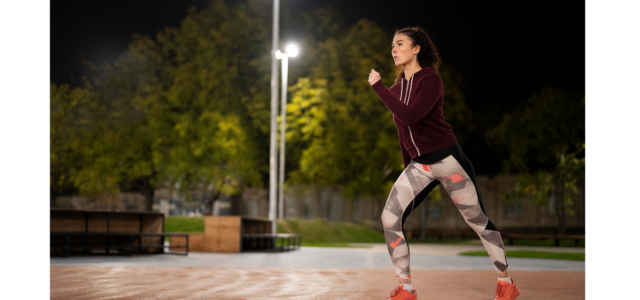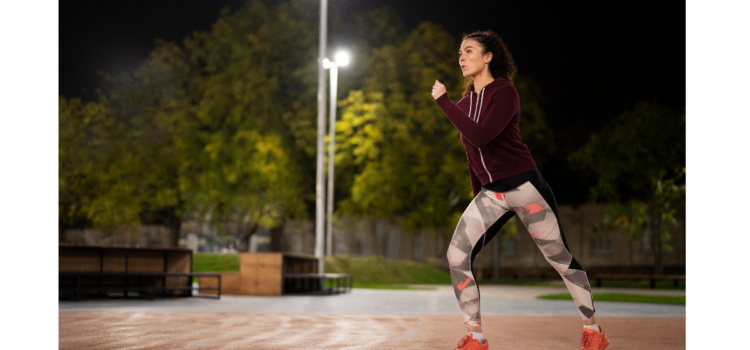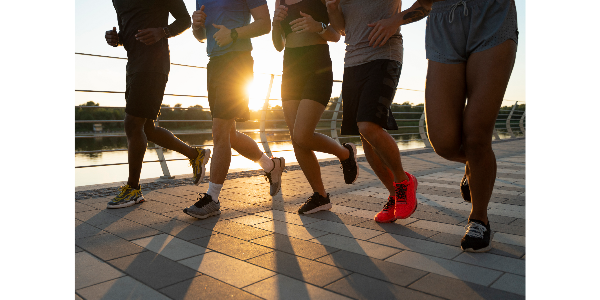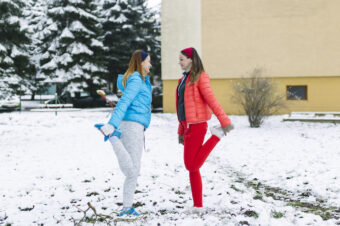

How To Stay Safe For Running In The Dark
BlogHealth & FitnessNewsOutdoorRunningStaffPicksXC-Track-Running September 17, 2024 Lauren Keating 5

7 Tips For Staying Safe For Fall Runs When It Starts To Get Dark
As the days grow shorter in the fall and winter months, youth runners often find themselves running in low-light conditions, whether it’s early in the morning, late in the afternoon, or night. While running in the dark can be a peaceful and invigorating experience, it also presents unique challenges and safety concerns. To ensure a safe and enjoyable run, youth runners should take extra precautions when running in low-light conditions. Here are some essential tips for staying safe while running in the dark.
There are some some key facts to keep in mind when thinking about how to stay safe when running in the dark during dal and winter runs. This includes avoiding running alone, wearing the right running gear to being visible, and having safety tools on hand in case of an emergency.
Here are the best tips for running once it starts to get dark.
1. Don’t Run Alone
There is something special about the solitude that running brings. It’s a time to self-reflect and feel connected to the outdoors especially as the night falls. With school or a full day of classes and part-time jobs, it may be hard to make time for runs. As a result, some prefer to rise and grind early—even before the sun fully provides some light.
No matter the time of day, but especially when it’s still dark, runners shouldn’t trek alone. Make plans with a cross country teammate, or a friend, or join a local running group to join others who also plan to get in an early or evening workout.
Running with others increases your visibility, but it also provides an added layer of security. It also means there is someone there in case of a trip, injury, or something more serious.
If you can’t run with a friend or group, make sure someone knows your route and expected return time. Stay close to home and avoid trail running alone to avoid the sun setting before the run is completed.
Plan early morning to late evening runs to be close to when the sun rises or with ample time to finish the workout before it’s completely dark. Use these workouts for shorter distances to avoid being out in the dark for a long time.

2. Wear Reflective Gear and Bright Colors
One of the most important safety tips for running in the dark is to stay visible. Wear reflective running gear such as reflective vests, armbands, and ankle bands that help drivers, cyclists, and other pedestrians see runners from a distance.
Put on jackets that have built-in reflective strips, which further add to visibility. Bright colors are also more visible in low light than dark colors. Opt for neon shades like yellow, orange, or green to stand out.
Reflective gear isn’t just for nighttime — early morning and dusk runs can also be low-visibility times so gear up appropriately.
3. A Headlamp or Flashlight Is A Must
Having light when out for a run is a necessity. Runners want to make sure cars can see them, but they also want to make sure they don’t trip or get lost in the darkness.
While smartphones have flashlights, it might not be ideal. Headlamps are the best running accessory for cross country runners who enjoy long distance.
Headlamps are a great idea for when on the trail and it’s close to sunset. Headlamps are beneficial because they keep your hands free while running, and many models offer adjustable beams to focus light where you need it most.
When it is dark outside—even when talking about those early morning workouts before school–bringing a handheld flashlight is another great tool. Not only does it help you see the path ahead, but it also makes you more visible to others.
Look for a headlamp or flashlight with at least 200 lumens of brightness to illuminate the path effectively. Some headlamps come with a red light setting, which can be less harsh on your eyes and helps preserve night vision.
4. Run Against Traffic
Always run against traffic when road running to keep safe no mattter the time of the day. This allows you to see oncoming vehicles and react if necessary. Running against traffic is especially important in low-light conditions, where it can be harder for drivers to see runners.
Run on the sidewalk when possible. If there is no sidewalk, stay as far to the left side of the road as possible, facing oncoming traffic. Stay alert to be able to react to cars turning, speeding, or when needing to share the road.
5. Pick Safe, Well-Lit Courses
Early morning and dark evenings are when outside can seem to be like ghostown. With few to no people out, fall fog, or blackened skies, it’s best to stick to well-lit, familiar routes. This will help runners avoid getting lost, stay visible in lowlight situatiuons, and prevent falls.
If possible, choose routes with streetlights, sidewalks, or running paths that are specifically designed for runners and pedestrians. Avoid running in areas with heavy traffic or where drivers may not expect to see a runner. Being familiar with your route also means you’ll know where there are safe places to turn around, get help, or take a break if needed.
Despite it being cross country season, running at a well-lit track on school grounds might be the safer option when running when starts to get dark. This is an ideal place to run when having to run alone because of school safety measures, security cameras, and the lights.
6. Limit Distractions
Early morning and night runs are not the ideal time to listen to music or podcasts. It’s best to limit distractions to increase awareness and stay safe. Try running with only one earbud in, or use bone-conduction headphones to hear your surroundings. This is important when running alone (try to always run with friends, especially if you know it will be dark out) so that you can hear someone else around, cars that may be behind, or an animal.
Plus, staying aware of your environment is crucial for identifying potential hazards, such as approaching vehicles, cyclists, or other runners.
Avoid looking at your phone while running. If you need to check directions or your progress, stop in a safe place before doing so. Always be aware of your surroundings, especially in low-visibility condition
7. Carry a Phone, ID, And Other Safety Gear
Always carry a phone and identification when running in the dark. In case of an emergency, your phone can be used to call for help, check your location, or communicate with others.
Running apps can track your location and share it with family members or friends if the runner stops or a sudden fall is detected. Always tell someone when you plan a run, where you are running, and what ttime to expect your return.
An ID, whether it’s a driver’s license, a student ID, or a special running ID bracelet, provides essential information for first responders if needed.
Purchase a running belt or armband to carry your phone and ID, as well as a few dollars in case you need to purchase water or hop on public transportation. There are other running safety gear from Go Guarded running rings for self-defense to Nathan’s Strobelight and She’s Birdie alarm.
Charge your phone before heading out, and enable any emergency features, such as SOS calls or location sharing.









DAMAN GAME
March 25, 2025 #1 AuthorGreat tips! I always struggle with staying motivated to run in the dark, but these safety measures really help. I’m definitely going to invest in some reflective gear and consider doing my runs in well-lit areas. Thanks for sharing!
NULLS BRAWL
May 16, 2025 #2 AuthorGreat tips! I’ve been hesitant to run at night, but the suggestions on visibility gear and route planning really help. I especially liked the reminder about staying aware of my surroundings. Thanks for the practical advice!
Lauren Keating
July 24, 2025 #3 AuthorTry running at night with a buddy, too!
bdg game
August 7, 2025 #4 AuthorGreat tips! I’ve always been nervous about running in the dark, but these safety tips make me feel more confident. I especially love the recommendation for reflective gear!
19 CLUB
August 11, 2025 #5 AuthorGreat tips! I especially appreciated the advice on wearing reflective gear and choosing well-lit routes. Staying safe while enjoying my evening runs is a top priority for me, and this post really highlighted some essential precautions. Thanks for sharing!